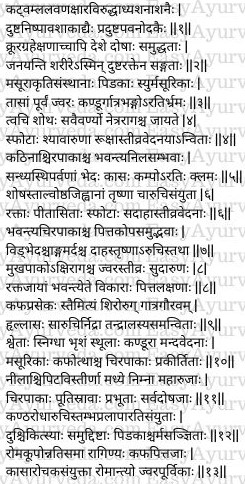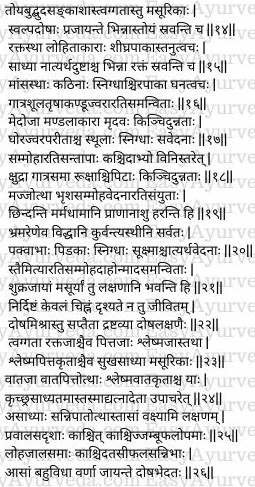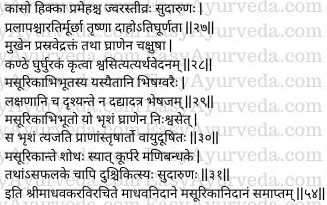Madhava Nidana Chapter 54 Masurika Nidanam

This article explains Madava nidana 54th chapter “Masurika Nidanam”. Causes, pathology and symptoms of Masurika are explained in this chapter. Masurika means smallpox.

Table of Contents
Masoorika Nidana
Etiological factors of Masurika
Below mentioned are the causative factors of masurika –
- excessive indulgence in foods which are pungent, sour, salty, alkaline and of incompatible nature (mutually opposite / antagonist foods)
- intake of foods in large quantities too frequently
- excessive consumption of contaminated foods, beans, and leafy vegetables
- excessive and repeated exposure to contaminated air and water
- influence of bad planetary positions (seeing bad planets which influences on certain areas of the country (in community of people)
Pathogenesis – Due to the above said etiological factors the doshas get aggravated in the entire body. These doshas get associated with the contaminated blood and produce eruptions on the body which resemble masura – lentils in shape and size and hence the name masurika. (1-2)
Read – Blisters: Ayuvedic Understanding, Treatment Principles
Masurika Purvarupa
Premonitory symptoms of Masurika
The premonitory symptoms of masurika include fever, itching, breaking pain all over the body, restlessness, giddiness, swelling in the skin, discolouration of skin and redness of the eyes. (3)

Vataja Masoorika
The symptoms of masurika caused by predominant vitiation of vata are – manifestation of eruptions which are black or crimson in color, dry, severely painful, hard and undergo slow suppuration. This condition is also associated with splitting pain in the joints, bones and small joints of the hands and feet, cough, tremors, restlessness, exhaustion, dryness of the palate, lips and tongue, thirst and loss of taste. (4-5)
Pittaja Masurika
The symptoms of masurika caused by predominant vitiation of pitta are – manifestation of eruptions which are red or yellowish white in colour associated with severe burning sensation and pain. These eruptions will undergo suppuration quickly. The patient would also have diarrhoea, pain as if someone has beaten all over the body, burning sensation, thirst, loss of taste, stomatitis (ulcerations in the mouth), redness of the eyes, very high fever and great distress. (6-7)
Read – Mouth Ulcers Ayurvedic Treatment, Medicines, Remedies, Tips
Raktaja Masurika
The symptoms of masurika caused by predominant vitiation of rakta (blood) are similar to those of pittaja masurika. (8)
Kaphaja Masurika
The symptoms of masurika caused by predominant vitiation of kapha are – excessive salivation (watery discharges from the mouth), feeling as though the body has been covered by wet leather or cloth, headache, heaviness of the body, nausea, loss of taste, excessive sleep, stupor and lassitude. The eruptions are white in colour, are unctuous, big in size, and are associated with itching and mild pain. In these eruptions the suppuration is slow. (9-10)
Read – Urticarial Rashes: Ayurvedic Understanding, Treatment, Medicines, Remedies
Sannipataja Masoorika
The symptoms of masurika caused by predominant vitiation of all three doshas together are – manifestation of eruptions which are blue in colour, flat, broad, depressed in the centre (and elevated at its edges) and severely painful. There is slow suppuration in these eruptions. Large quantities of foul smelling discharges come out of the eruptions (pus with offensive smell). There is also obstruction in the throat, loss of taste, stiffness of the body, delirium and restlessness. This condition is also called Carmapidaka. This condition caused by aggravation of all the three doshas together is difficult to treat. (11-12)
Romantika
Small, red eruptions occurring at the roots of the hairs making slight elevations which appear like raised sweat glands / pores, caused by abnormal increase of kapha and pitta are called Romantika (measles). This condition is associated with cough, loss of taste and preceded by fever. (13)
Read – Charaka – Shotha Chikitsa 12th Chapter

Dhatugata Masoorika
Twak-gata Masurika – When masurika is localised in the skin (affecting the rasa tissue), the eruptions would appear like water bubbles, discharge thin watery fluid on pricking and will have mild aggravation of doshas.
Raktagata Masurika – If Masurika is localized in the blood tissue, the eruptions would be red in colour, suppurates quickly, with thin skin. These are curable when they do not have severe vitiation of doshas. When these eruptions are pricked, they discharge blood.
Mamsagata Masurika – When the disease is localized in the muscle tissue, the eruptions are hard, unctuous, undergo suppuration slowly, and are covered with a thick layer of skin. This condition is associated with pain all over the body, thirst, itching, fever and restlessness.
Medogata Masurika – If the disease masurika invades and gets localized in the fat tissue there is manifestation of eruptions which are in the form of round patches, soft and slightly elevated, large, unctuous (greasy), painful and accompanied with very high fever, delusion, restlessness and distress (raised heat in the body and mind). Few people would get over these conditions.
Majjagata Masurika – If masurika is localized in the bone marrow there is manifestation of eruptions which are small in size, have the same colour as that of the skin, dry, flat or slightly elevated. It is associated with severe delusion, pain, and restlessness.
Asthigata Masurika – If masurika is localized in the bones, there will be cutting pain in the marmas i.e., vital organs which would pose threat to life. The bones would appear as though many bees have made many holes (perforations) in the bones (pain in the bones as though stung by bees).
Shukragata Masurika – When masurika gets lodged in the semen, there is a manifestation of eruptions which are ripened, unctuous (greasy, waxy), small in size, severely painful. The person would feel as if covered by wet leather or cloth and will also experience restlessness, delusion, burning sensation and insanity (intoxication). The symptoms of this condition are formally explained. In any case, the patient would lose his life quickly.
These (above said) seven types of masurika located in the tissues are always associated with vata and other (pitta, kapha) doshas. Therefore, they might have symptoms of one or more of the increased doshas. They should be understood on the basis of the symptoms of increased doshas associated with masurika located in the tissues.
Masurika resides in the skin and blood, and those caused by vitiated pitta, kapha and kapha-pitta are easy to cure. (14-23)
Read – Visphota: Causes, Types, Treatment, Medicines
Prognosis of Masurika
Masurika caused by vata, vāta-pitta, kapha-vata are very difficult to cure. Therefore, they shall be treated with great care and effort.
Masurika caused by sannipata i.e., all the vitiated doshas combined together is incurable. Their symptoms are hereby explained. The eruptions resemble coral beads in colour, and some resemble fruits of jambu (Eugenia jambolana) and some others appear like an iron sieve. Some others resemble fruits of atasi (linseed).
The eruptions of masurika will also have many other colours depending on the type of dosha or doshas involved therein. (24-26)

Other symptoms of incurability of masurika
When the below mentioned symptoms are found in a patient suffering from masurika he should not be administered with medicines and should be refused treatment (since it indicates that masurika associated with these symptoms is incurable) –
- cough,
- hiccough,
- diabetes,
- high fever,
- severe delirium,
- restlessness,
- fainting,
- thirst,
- burning sensation,
- excessive curvature of the body (cramps, excessive yawning)
- bleeding from the mouth, nose and eyes
- patient breathes with severe pain and difficulty while making cooing sounds in the throat (27-29)
Other symptoms of incurability
The patient of masurika who is breathing only through his nose (very shallow breathing), has severe thirst and whose vata is severely aggravated, is definitely going to die soon. (30)
Read – Symptoms Of Vata Dosha Increase And Imbalance – Vata Vruddhi Lakshana
Upadrava
Complications of masurika
When at the end of masurika (last stages of masurika), if the patient develops profound swelling in the elbow, wrist and shoulder joints (shoulder blades, scapulae), the disease should be considered as incurable. (31)
Thus ends the chapter on Masurika Nidanam in Madhava Nidana text written by Acharya Madhavakara.










